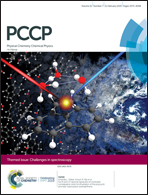Elucidating the role of key structural motifs in antifreeze glycoproteins†
Abstract
Antifreeze glycoproteins (AFGPs) are distinctively riveting class of bio-macromolecules, which endows the survival of organisms inhabiting polar and subpolar regions. These proteins are believed to hinder microscopic freezing by interacting with embryonic ice crystals and precluding their further growth. The underlying molecular mechanism by which AFGPs bind to ice has remained elusive due to insufficient structural characterization, with conflicting hypotheses on the possible binding mode of AFGPs – either via the hydrophobic peptide backbone or via the hydrophilic carbohydrate side chains – when interacting with ice. Chemical synthesis has allowed researchers to access synthetic variants of natural AFGPs. These studies revealed that AFGPs exhibit huge variations in their thermal hysteresis and ice shaping behavior with only slight structural variations, especially to the carbohydrate side chains. Four key structural motifs were identified as crucial to AFGP activity: the presence of a threonine γ-methyl group, an α-glycosidic carbohydrate–protein linkage, an acetylamide group (–NHCOCH3) at the C2 position of the carbohydrate linked to the protein, and the presence of carbohydrate hydroxyl groups. In this study, we use molecular dynamics (MD) simulations to probe the microscopic properties of water accompanying these structural variations of AFGPs. We find that these variations primarily influence the conformation space of AFGPs and also crucially control their hydration dynamics. Owing to the disordered nature of AFGPs we use Markov-state modeling to identify the conformational preferences of AFGPs. The simulations reveal the importance of steric bulk, intra-molecular carbohydrate–protein H-bonds and conformational preferences (α- vs. β-linkages) in controlling the spatial segregation of the hydrophilic and hydrophobic regions of AFGPs. We hypothesize that the hydrophobic component of AFGPs is crucial to their binding to ice, which determines the ice shaping ability of AFGPs. However, the hydrophilic carbohydrate hydroxyl groups and their ability to form water bridges control the subsequent hydration dynamics, which is key to the antifreeze properties. Investigating the tetrahedral order parameter of water molecules around the carbohydrates revealed competition between solute- and bulk-influenced solvent structures, with maximum restructuring being observed in the interfacial region 2.5–4.5 Å away from the AFGPs.



 Please wait while we load your content...
Please wait while we load your content...